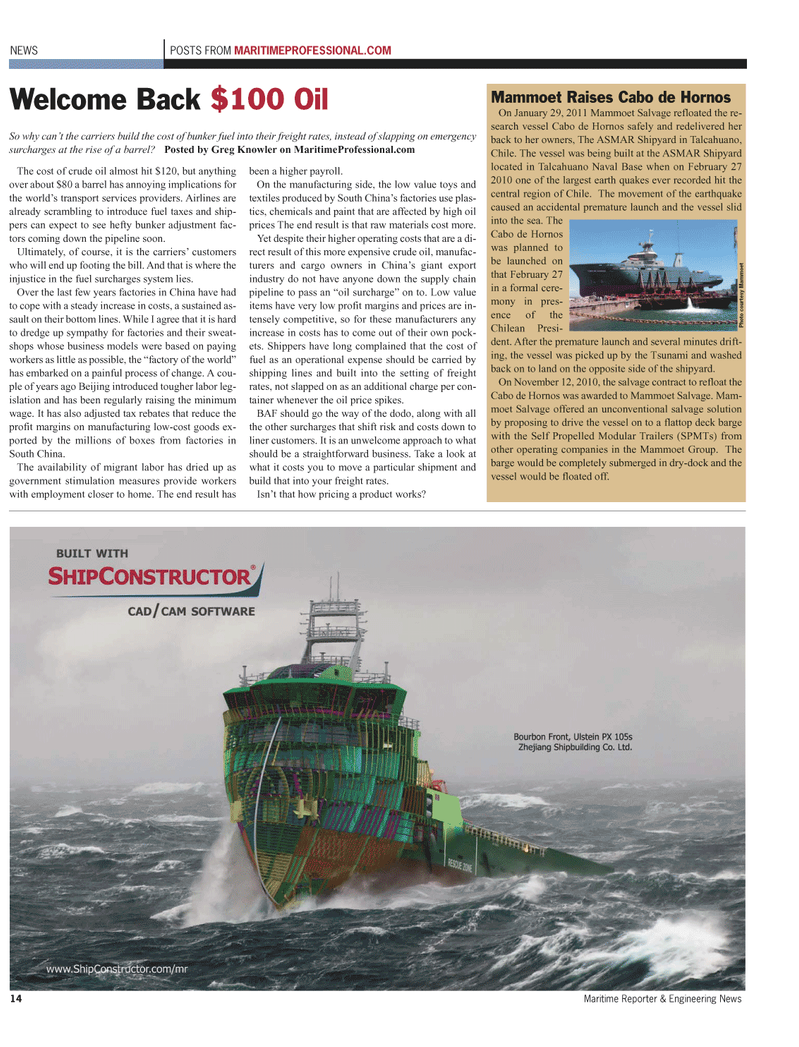
Page 14: of Maritime Reporter Magazine (March 2011)
Ship Repair & Conversion
Read this page in Pdf, Flash or Html5 edition of March 2011 Maritime Reporter Magazine
14 Maritime Reporter & Engineering News
The cost of crude oil almost hit $120, but anything over about $80 a barrel has annoying implications for the world’s transport services providers. Airlines are already scrambling to introduce fuel taxes and ship- pers can expect to see hefty bunker adjustment fac- tors coming down the pipeline soon.
Ultimately, of course, it is the carriers’ customers who will end up footing the bill. And that is where the injustice in the fuel surcharges system lies.
Over the last few years factories in China have had to cope with a steady increase in costs, a sustained as- sault on their bottom lines. While I agree that it is hard to dredge up sympathy for factories and their sweat- shops whose business models were based on paying workers as little as possible, the “factory of the world” has embarked on a painful process of change. A cou- ple of years ago Beijing introduced tougher labor leg- islation and has been regularly raising the minimum wage. It has also adjusted tax rebates that reduce the profit margins on manufacturing low-cost goods ex- ported by the millions of boxes from factories in
South China.
The availability of migrant labor has dried up as government stimulation measures provide workers with employment closer to home. The end result has been a higher payroll.
On the manufacturing side, the low value toys and textiles produced by South China’s factories use plas- tics, chemicals and paint that are affected by high oil prices The end result is that raw materials cost more.
Yet despite their higher operating costs that are a di- rect result of this more expensive crude oil, manufac- turers and cargo owners in China’s giant export industry do not have anyone down the supply chain pipeline to pass an “oil surcharge” on to. Low value items have very low profit margins and prices are in- tensely competitive, so for these manufacturers any increase in costs has to come out of their own pock- ets. Shippers have long complained that the cost of fuel as an operational expense should be carried by shipping lines and built into the setting of freight rates, not slapped on as an additional charge per con- tainer whenever the oil price spikes.
BAF should go the way of the dodo, along with all the other surcharges that shift risk and costs down to liner customers. It is an unwelcome approach to what should be a straightforward business. Take a look at what it costs you to move a particular shipment and build that into your freight rates.
Isn’t that how pricing a product works?
NEWS POSTS FROM MARITIMEPROFESSIONAL.COM
Welcome Back $100 Oil
So why can’t the carriers build the cost of bunker fuel into their freight rates, instead of slapping on emergency surcharges at the rise of a barrel? Posted by Greg Knowler on MaritimeProfessional.com
Mammoet Raises Cabo de Hornos
On January 29, 2011 Mammoet Salvage refloated the re- search vessel Cabo de Hornos safely and redelivered her back to her owners, The ASMAR Shipyard in Talcahuano,
Chile. The vessel was being built at the ASMAR Shipyard located in Talcahuano Naval Base when on February 27 2010 one of the largest earth quakes ever recorded hit the central region of Chile. The movement of the earthquake caused an accidental premature launch and the vessel slid into the sea. The
Cabo de Hornos was planned to be launched on that February 27 in a formal cere- mony in pres- ence of the
Chilean Presi- dent. After the premature launch and several minutes drift- ing, the vessel was picked up by the Tsunami and washed back on to land on the opposite side of the shipyard.
On November 12, 2010, the salvage contract to refloat the
Cabo de Hornos was awarded to Mammoet Salvage. Mam- moet Salvage offered an unconventional salvage solution by proposing to drive the vessel on to a flattop deck barge with the Self Propelled Modular Trailers (SPMTs) from other operating companies in the Mammoet Group. The barge would be completely submerged in dry-dock and the vessel would be floated off.
Photo cour tesy Mammoet

 13
13

 15
15
